Land Cover Change in the Abuja City-Region, Nigeria: Integrating GIS and Remotely Sensed Data to Support Land Use Planning
Abstract
1. Introduction
2. Materials and Methods
2.1. Study Area
2.2. Data Collection
2.3. Data Analysis
3. Results
4. Discussion
5. Conclusions
Author Contributions
Acknowledgments
Conflicts of Interest
References
- Nor, A.N.M.; Corstannje, R.; Harris, J.A.; Brewer, T. Impact of rapid urban expansion on green space structure. Ecol. Indic. 2017, 81, 274–284. [Google Scholar] [CrossRef]
- Zhou, Y.; Li, X.; Asrar, G.R.; Smith, S.J.; Imhoff, M. A global record of annual urban dynamics (1992–2013) from nighttime lights. Remote Sens. Environ. 2018, 219, 206–220. [Google Scholar] [CrossRef]
- Angel, S.; Parent, J.; Civco, D.L.; Blei, A.; Potere, D. The dimensions of global urban expansion: Estimates and projections for all countries, 2000–2050. Prog. Plan. 2011, 75, 53–107. [Google Scholar] [CrossRef]
- Vasenev, V.I.; Stoorvogal, J.J.; Leemans, R.; Valentini, R.; Hajiaghayeva, R.A. Projection of urban expansion and related changes in soil carbon stocks in the Moscow Region. J. Clean. Prod. 2018, 170, 902–914. [Google Scholar] [CrossRef]
- Kukkonen, M.O.; Muhammad, M.J.; Käyhkö, N.; Luoto, M. Urban expansion in Zanzibar City, Tanzania: Analyzing quantity, spatial patterns and effects of alternative planning approaches. Land Use Policy 2018, 71, 554–565. [Google Scholar] [CrossRef]
- Tiitu, M. Expansion of the built-up areas in Finnish city regions—The approach of travel-related urban zones. Appl. Geogr. 2018, 101, 1–13. [Google Scholar] [CrossRef]
- Akpu, B.; Tanko, A.I.; Jeb, D.N.; Dogo, B. Geospatial Analysis of Urban Expansion and Its Impact on Vegetation Cover in Kaduna Metropolis, Nigeria. AJEE 2017, 3, 31149. [Google Scholar] [CrossRef]
- Owoeye, J.O.; Ibitoye, O.A. Analysis of Akure Urban Land Use Change Detection from Remote Imagery Perspective. Urban Stud. Res. 2016, 2016, 4673019. [Google Scholar] [CrossRef]
- Gibson, J.; Boe-Gibson, G.; Stichbury, G. Urban land expansion in India 1992–2012. Food Pol. 2015, 56, 100–113. [Google Scholar] [CrossRef]
- Quan, B.; Bai, Y.; Romkens, M.J.M.; Chang, K.; Song, H.; Guo, T.; Lei, S. Urban land expansion in Quanzhou City, China, 1995–2010. Habitat Int. 2015, 48, 131–139. [Google Scholar] [CrossRef]
- Fanan, U.; Dlama, K.I.; Oluseyi, I.O. Urban expansion and vegetal cover loss in and around Nigeria’s Federal Capital City. J. Ecol. Nat. Environ. 2011, 3, 1–10. Available online: https://academicjournals.org/journal/JENE/article-abstract/CE94A3B5892 (accessed on 20 December 2017).
- Barrera, F.D.L.; Henríquez, C. Vegetation cover change in growing urban agglomerations in Chile. Ecol. Indic. 2017, 81, 265–273. [Google Scholar] [CrossRef]
- Nwokoro, I.I.; Dekolo, S.O. Land use change and environmental sustainability: The case of Lagos Metropolis. In Sustainable City VII: Urban Regeneration and Sustainability; Pacetti, M., Passerini, G., Brebbia, C.A., Latini, G., Eds.; WIT Press: Southampton, UK, 2012; Volume 155, pp. 157–167. [Google Scholar]
- Morelli, J. Environmental Sustainability: A Definition for Environmental Professionals. J. Environ. Sustain. 2011, 1, 19–27. [Google Scholar] [CrossRef]
- Abdullahi, S.; Pradhan, B. Sustainable Urban Development. In Spatial Modeling and Assessment of Urban Form Analysis of Urban Growth: From Sprawl to Compact Using Geospatial Data, 1st ed.; Pradhan, B., Ed.; Springer International Publishing AG: Basel, Switzerland, 2017; pp. 17–34. ISBN 978-3-319-54216-4. [Google Scholar]
- Yin, J. Urban Planning for Dummies, 3rd ed.; John Wiley & Sons Canada Ltd.: Mississauga, ON, Canada, 2012. [Google Scholar]
- UN-Habitat. State of the World’s Cities 2010/2011: Bridging the Urban Divide; Earthscan Publishing for a Sustainable Future: London, UK, 2008. [Google Scholar]
- Phillips, P.M.; João, E. Land use planning and the ecosystem approach: An evaluation of case study planning frameworks against the Malawi Principles. Land Use Policy 2017, 68, 460–480. [Google Scholar] [CrossRef]
- BMZ. Land Use Planning: Concept, Tools and Applications; GIZ: Eschborn, Germany, 2012. [Google Scholar]
- Metternicht, G. Global Land Outlook Working Paper: Land Use Planning; UNCCD (United Nations Convention to Combat Desertification): Sydney, Australia, 2017. [Google Scholar]
- Schug, F.; Okujeni, A.; Hauer, J.; Hostert, P.; Nielsen, J.O.; van der Linden, S.F. Mapping pattern of urban development in Ouagadougou, Burkina Faso, using machine learning regression modeling with bi-seasonal Landsat time series. Remote Sens. Environ. 2018, 210, 217–228. [Google Scholar] [CrossRef]
- Aribigbola, A. Constraints to Urban Land Use Planning and Management in Nigeria: Evidence from Ondo State. J. Environ. 2013, 2, 66–73. Available online: https://www.scientific-journals.co.uk/web_documents/4020311_constraints_urban_land_use.pdf (accessed on 21 December 2017).
- Potts, D. Challenging the Myths of Urban Dynamics in Sub-Saharan Africa: The Evidence from Nigeria. World Dev. 2012, 40, 1382–1393. [Google Scholar] [CrossRef]
- Africa in Focus Figure of the Week: Africa is Home to the 10 Fastest Growing Cities in The World. Available online: https://www.brookings.edu/blog/africa-in-focus/2018/10/05/figure-of-the-week-africa-is-home-to-fastest-growing-cities-in-the-world/ (accessed on 5 October 2018).
- Mahmoud, M.I.; Duker, A.; Conrad, C.; Thiel, M.; Ahmad, H.S. Analysis of Settlement Expansion and Urban Growth Modelling Using Geoinformation for Assessing Potential Impacts of Urbanization on Climate in Abuja City, Nigeria. Remote Sens. 2016, 8, 220. [Google Scholar] [CrossRef]
- Nkeki, F.N. Spatio-temporal analysis of land use transition and urban growth characterization in Benin metropolitan region, Nigeria. Remote Sens. Appl. Soc. Environ. 2016, 4, 119–137. [Google Scholar] [CrossRef]
- Akintunde, J.A.; Adzandeh, E.A.; Fabiyi, O.O. Spatio-temporal pattern of urban growth in Jos Metropolis, Nigeria. Remote Sens. Appl. Soc. Environ. 2016, 4, 44–54. [Google Scholar] [CrossRef]
- Hou, H.; Estoque, R.C.; Murayama, Y. Spatiotemporal analysis of urban growth in three African capital cities: A grid-cell-based analysis using remote sensing data. J. Afr. Earth Sci. 2016, 123, 381–391. [Google Scholar] [CrossRef]
- Liu, F.; Zhang, Z.; Zhao, X.; Wang, X.; Zuo, L.; Wen, Q.; Yi, L.; Xu, J.; Hu, S.; Liu, B. Chinese cropland losses due to urban expansion in the past four decades. Sci. Total Environ. 2019, 650, 847–857. [Google Scholar] [CrossRef] [PubMed]
- Abubakar, I.R. Abuja city profile. Cities 2014, 41, 81–91. [Google Scholar] [CrossRef]
- FMITI (Federal Ministry of Industry, Trade and Investment). Resettlement and Social Audit: Abuja Technology Village Project; FMITI: Abuja, Nigeria, 2015.
- COHRE (The Centre on Housing Rights and Evictions); SERAC (Social and Economic Rights Action Centre). The Myth of Abuja Master Plan: Forced Evictions as Urban Planning in Abuja, Nigeria; COHRE: Geneva, Switzerland, 2008; ISBN 978-92-95004-43-6. [Google Scholar]
- Idoko, M.A.; Bisong, F.E. Application of Geo-Information for Evaluation of Land Use Change: A Case Study of Federal Capital Territory-Abuja. Environ. Res. J. 2010, 4, 140–144. [Google Scholar] [CrossRef]
- Omole, F.K. Land use violations: Implication for sustainable development, the case study of the Federal Capital City Abuja, Nigeria. Curr. Res. J. Soc. Sci. 2009, 1, 31–37. Available online: https://maxwellsci.com/jp/abstract.php?jid=CRJSS&no=3&abs=6 (accessed on 22 December 2017).
- City Population: Federal Capital Territory, Nigeria. Available online: https://www.citypopulation.de/php/nigeria-admin.php?adm1id=NGA015 (accessed on 22 December 2017).
- DEPRS (Department of Economic Planning and Research Statistics). 2015 Statistical Year Book; National Bureau of Statistics: Abuja, Nigeria, 2015.
- Ujoh, F.; Kwabe, I.D.; Ifatimehin, O.O. Understanding urban sprawl in the Federal Capital City, Abuja: Towards sustainable urbanization in Nigeria. J. Geogr. Reg. Plann. 2010, 3, 106–113. Available online: https://academicjournals.org/journal/JGRP/article-abstract/5DEAA5539644 (accessed on 6 January 2018).
- Jibril, I.U. Planning and Land Administration Challenges in Developing New Cities: The Abuja Experience in Nigeria. In Proceedings of the FIG Working Week, Sofia, Bulgaria, 17–21 May 2015. [Google Scholar]
- Aliyu, R. Designing for Sustainable Communities: The Abuja Federal Capital Territory of Nigeria. Ph.D. Thesis, De Montfort University Leicester, Leicester, UK, June 2016. [Google Scholar]
- Jelili, M.O.; Adedibu, A.A.; Egunjobi, L. Regional Development Planning in Nigeria: The General and Particular. J. Soc. Sci. 2008, 16, 135–140. [Google Scholar] [CrossRef]
- Usman, I.J. An evaluation of the influence of Land-Use/Cover Change on the Surface Temperature of Federal Capital City (Abuja) Using Remote Sensing and GIS. Master’s Thesis, Ahmadu Bello University Zaria, Zaria, Nigeria, February 2014. [Google Scholar]
- Edicha, J.A.; Mgbanyi, L.L.O. Assessment of soil structural stability under different vegetal cover conditions in the Federal Capital Territory, Abuja, Nigeria. Niger. Geogr. J. 2013, 9, 110–121. Available online: https://www.researchgate.net/publication/274384618 (accessed on 22 December 2017).
- USGS (United States Geological Survey). Available online: https://earthexplorer.usgs.gov (accessed on 10 June 2017).
- AGIS (Abuja Geographic Information Systems). FCT Regional Plan 2000: Proposed Landuse; AGIS: Abuja, Nigeria, 2007.
- Fola Consult Ltd. Federal Capital City: Revised Land Use Plan—2011 Phases I, II & III; Federal Capital Development Authority: Abuja, Nigeria, 2011.
- Campbell, J.B.; Wynne, R.H. Introduction to Remote Sensing, 5th ed.; The Guilford Press: New York, NY, USA, 2011. [Google Scholar]
- Lu, D.; Weng, Q.; Moran, E.; Li, G.; Hetrick, S. Remote Sensing Image Classification. In Advances in Environmental Remote Sensing: Sensors, Algorithms, and Applications, 1st ed.; Weng, Q., Ed.; Tailor & Francis Group: Boca Raton, FL, USA, 2011; pp. 219–240. ISBN 978-1-4200-9175-5. [Google Scholar]
- Tso, B.; Mather, P.M. Classification Methods for Remotely Sensed Data, 2nd ed.; Taylor & Francis Group, LLC: Boca Raton, FL, USA, 2009; ISBN 978-1-42009072-7. [Google Scholar]
- Ganasri, B.P.; Dwarakish, G.S. Study of land use/land cover dynamics through classification algorithms for Harangi catchment area, Karnataka State, INDIA. Aquat. Procedia 2015, 4, 1413–1420. [Google Scholar] [CrossRef]
- Olofsson, P.; Foody, G.M.; Herold, M.; Stehman, S.V.; Woodcock, C.E.; Wulder, M.A. Good practices for estimating area and assessing accuracy of land change. Remote Sens. Environ. 2014, 148, 42–57. [Google Scholar] [CrossRef]
- Yang, X. Integration of Remote Sensing with GIS for Urban Growth Characterization. In Geospatial Analysis and Modelling of Urban Structure and Dynamics, 1st ed.; Jiang, B., Yao, X., Eds.; Springer Science + Business Media B.V.: New York, NY, USA, 2010; pp. 223–250. ISBN 978-90-481-8571-9. [Google Scholar]
- Elagouz, M.H.; Abou-Shleel, S.M.; Belal, A.A.; El-Mohandes, M.A. Detection of land use/cover change in Egyptian Nile Delta using remote sensing. Egypt. J. Remote Sens. Space Sci. 2019. [Google Scholar] [CrossRef]
- Shen, X.; Wang, X.; Zhang, Z.; Lu, Z.; Lv, T. Evaluating the effectiveness of land use plans in containing urban expansion: An integrated view. Land Use Policy 2019, 80, 205–213. [Google Scholar] [CrossRef]
- Hassan, M.M. Monitoring land use/land cover change, urban growth dynamics and landscape pattern analysis in five fastest urbanized cities in Bangladesh. Remote Sens. Appl. Soc. Environ. 2017, 7, 69–83. [Google Scholar] [CrossRef]
- Gottdiener, M.; Budd, L.; Lehtovuori, P. Key Concepts in Urban Studies; Saga Publications Ltd.: London, UK, 2016; ISBN 978-1-84920-198-8. [Google Scholar]
- Lall, S.V.; Henderson, V.J.; Venables, A.J. Africa’s Cities: Opening Doors to the World; International Bank for Reconstruction and Development/The World Bank: Washington, DC, USA, 2017; pp. 1–162. ISBN 978-1-4648-1044-2. [Google Scholar]
- Zubair, O.A.; Ojigi, L.M.; Mbih, R.A. Urbanization: A Catalyst for the Emergence of Squatter Settlements and Squalor in the Vicinities of the Federal Capital City of Nigeria. J. Sustain. Dev. 2015, 8, 134–148. [Google Scholar] [CrossRef]
- Freire, M.O.; Lall, S.; Leipzige, D. Africa’s Urbanization: Challenges and Opportunities; Working Paper No. 7; The Growth Dialogue: Washington, DC, USA, 2014; pp. 1–30. [Google Scholar]
- Trefon, T. Hings and fringes: Conceptualising the peri-urban in Central Africa. In African Cities: Completing Claims on Urban Spaces, 1st ed.; Locatelli, F., Nugent, P., Eds.; Koninklijke Brill NV: Leiden, The Netherlands, 2009; Volume 3, pp. 15–36. ISBN 9789047442486. [Google Scholar]
- Goodfellow, T. Planning and development regulation amid rapid urban growth: Explaining divergent trajectories in Africa. Geoforum 2013, 48, 83–93. [Google Scholar] [CrossRef]
- Barry, M.; Danso, E.K. Tenure security, land registration and customary tenure in a peri-urban Accra community. Land Use Policy 2014, 39, 358–365. [Google Scholar] [CrossRef]
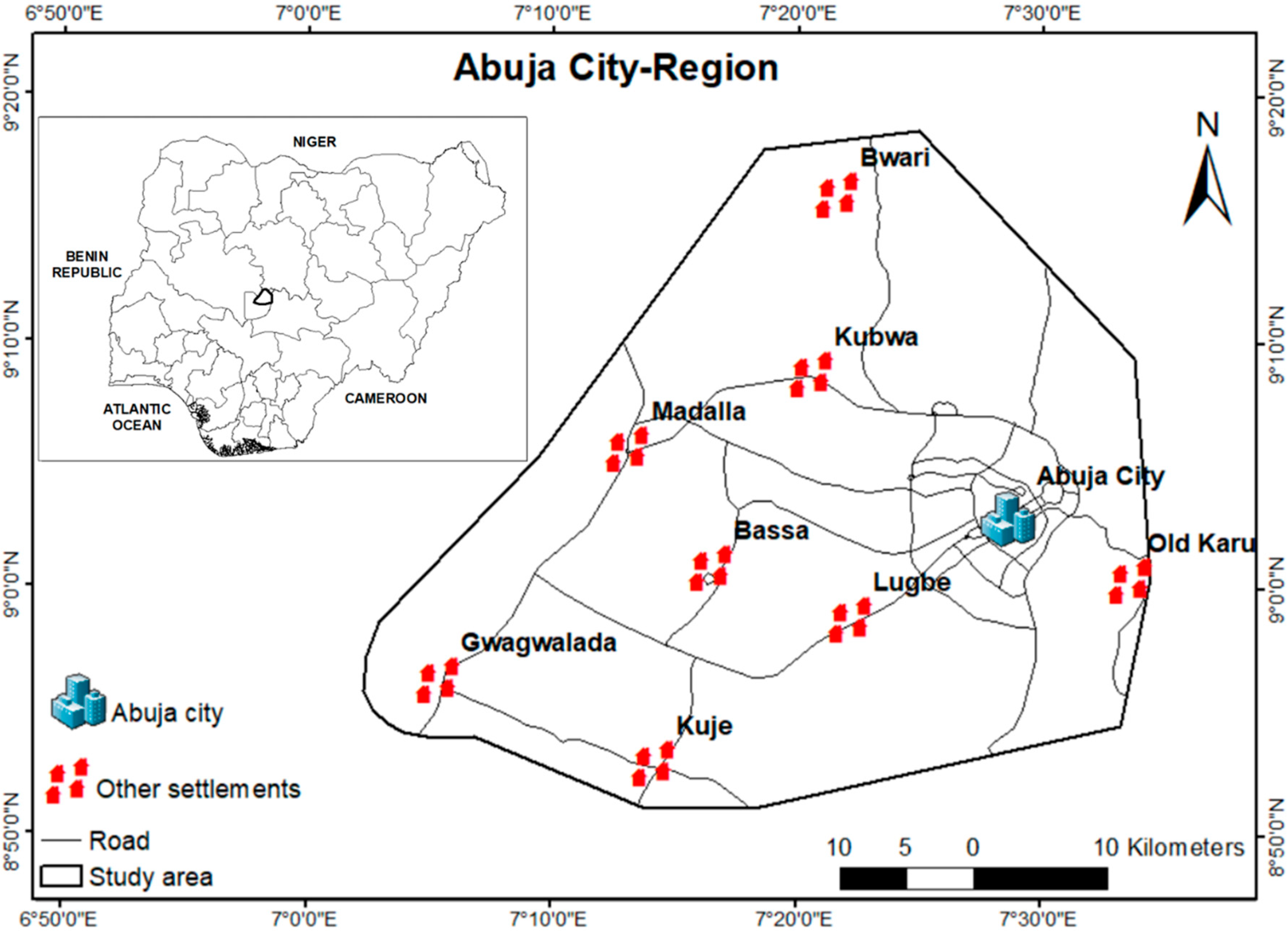
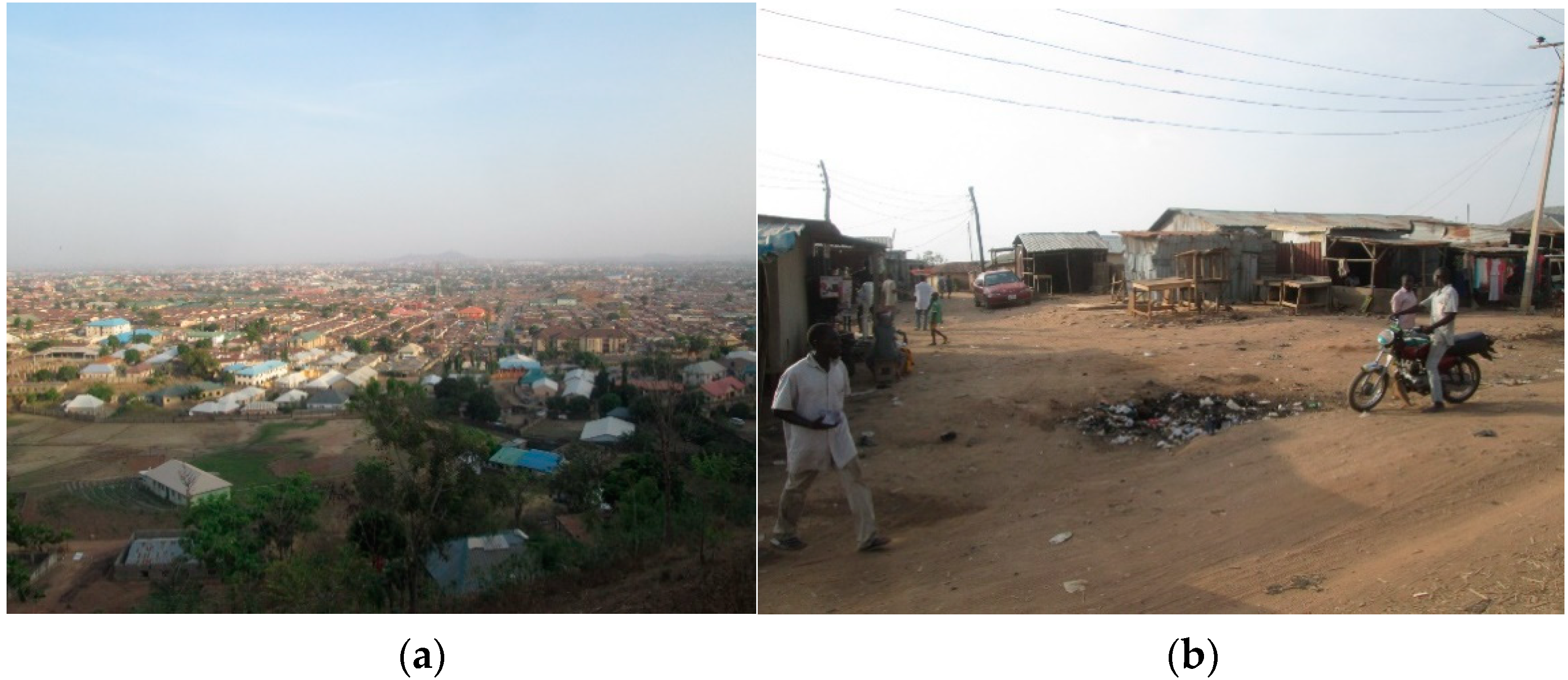
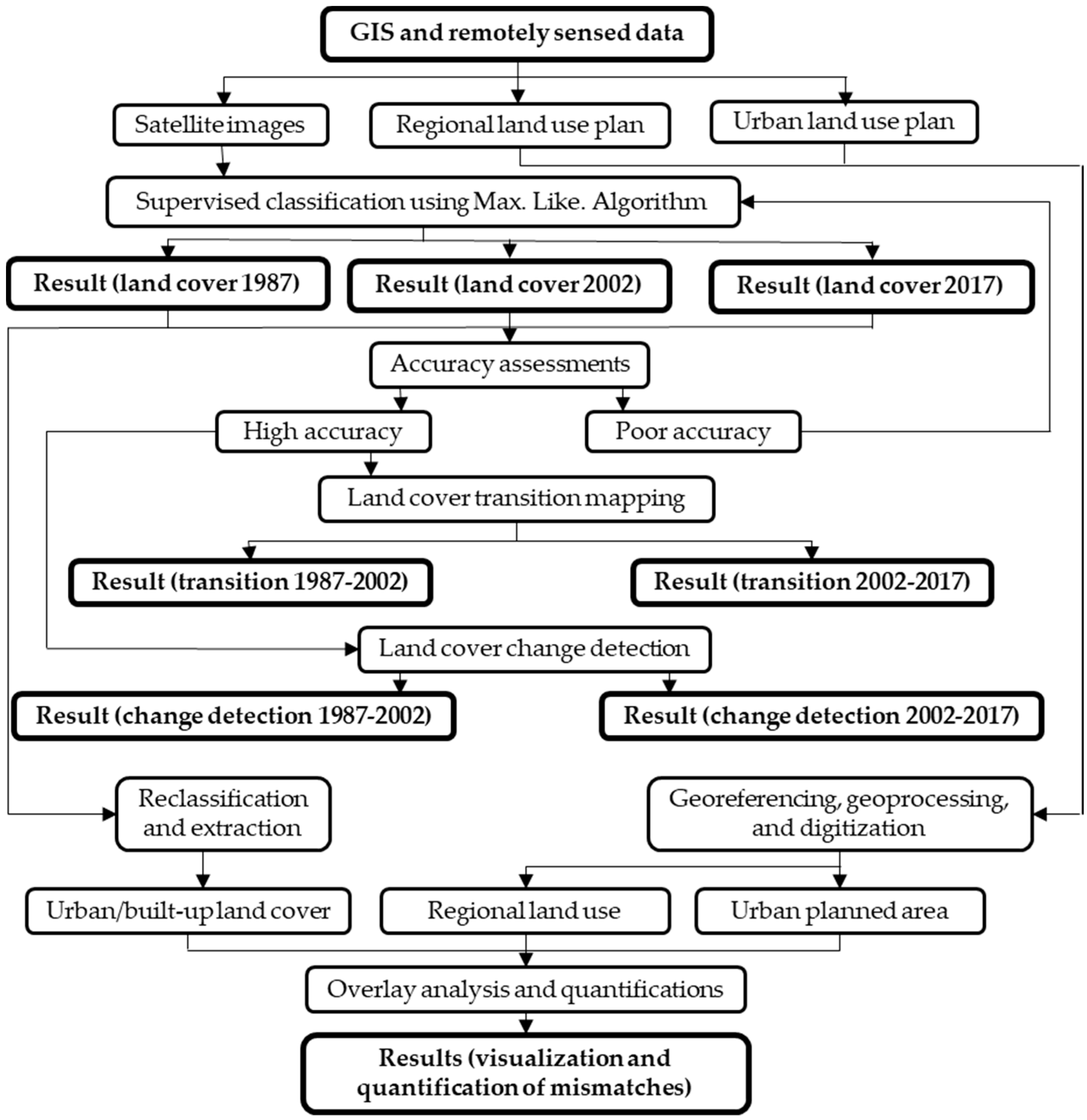
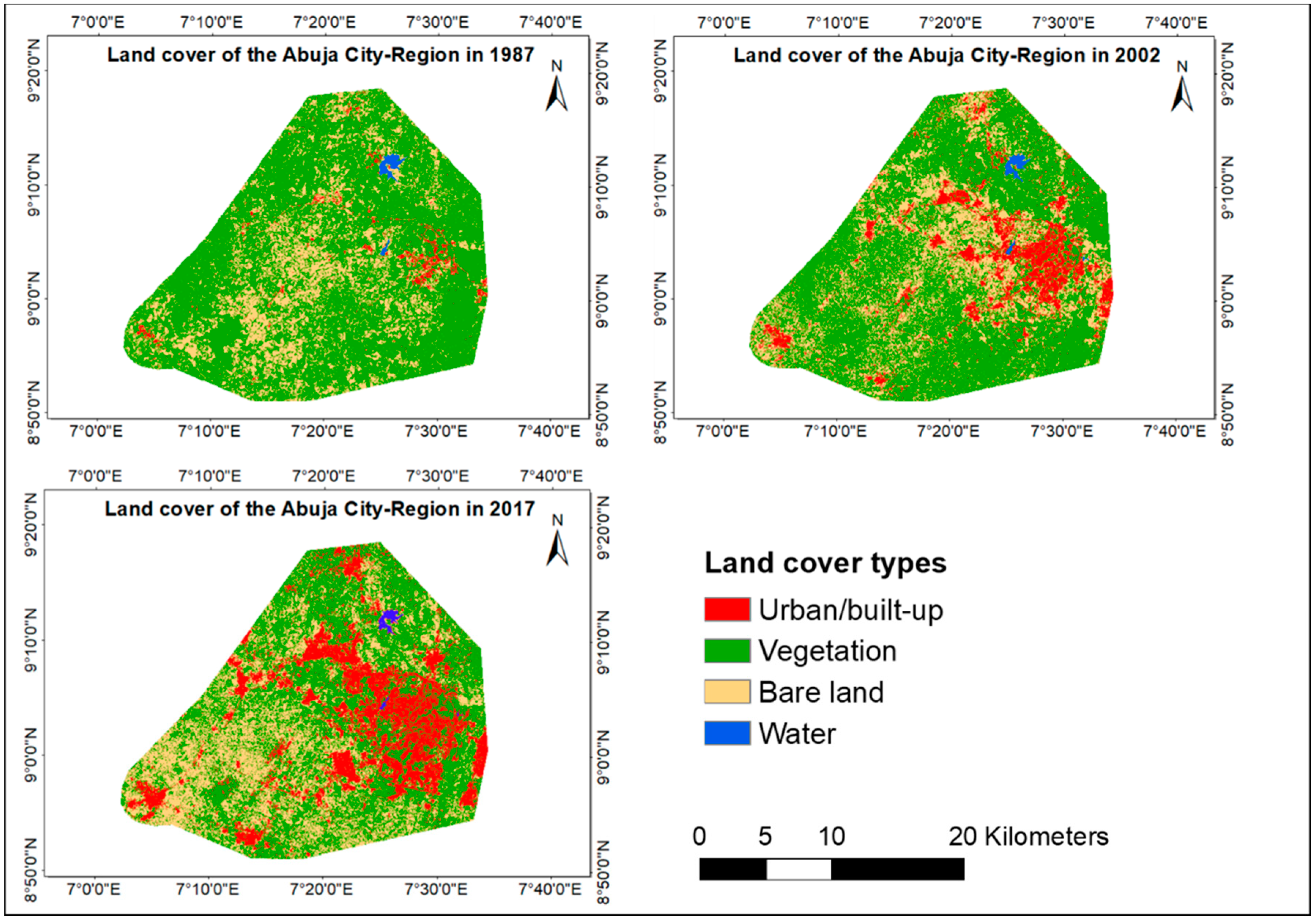
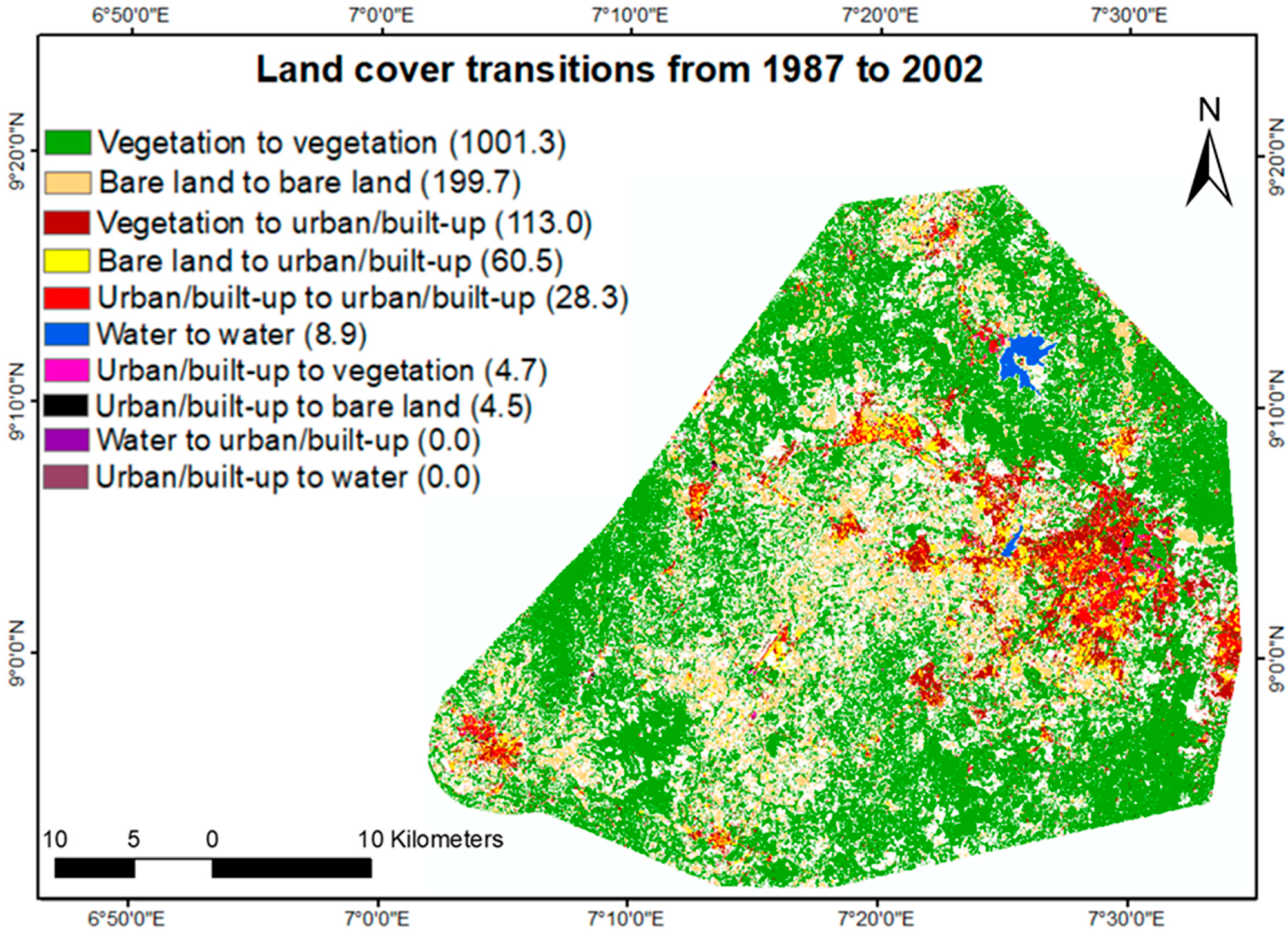



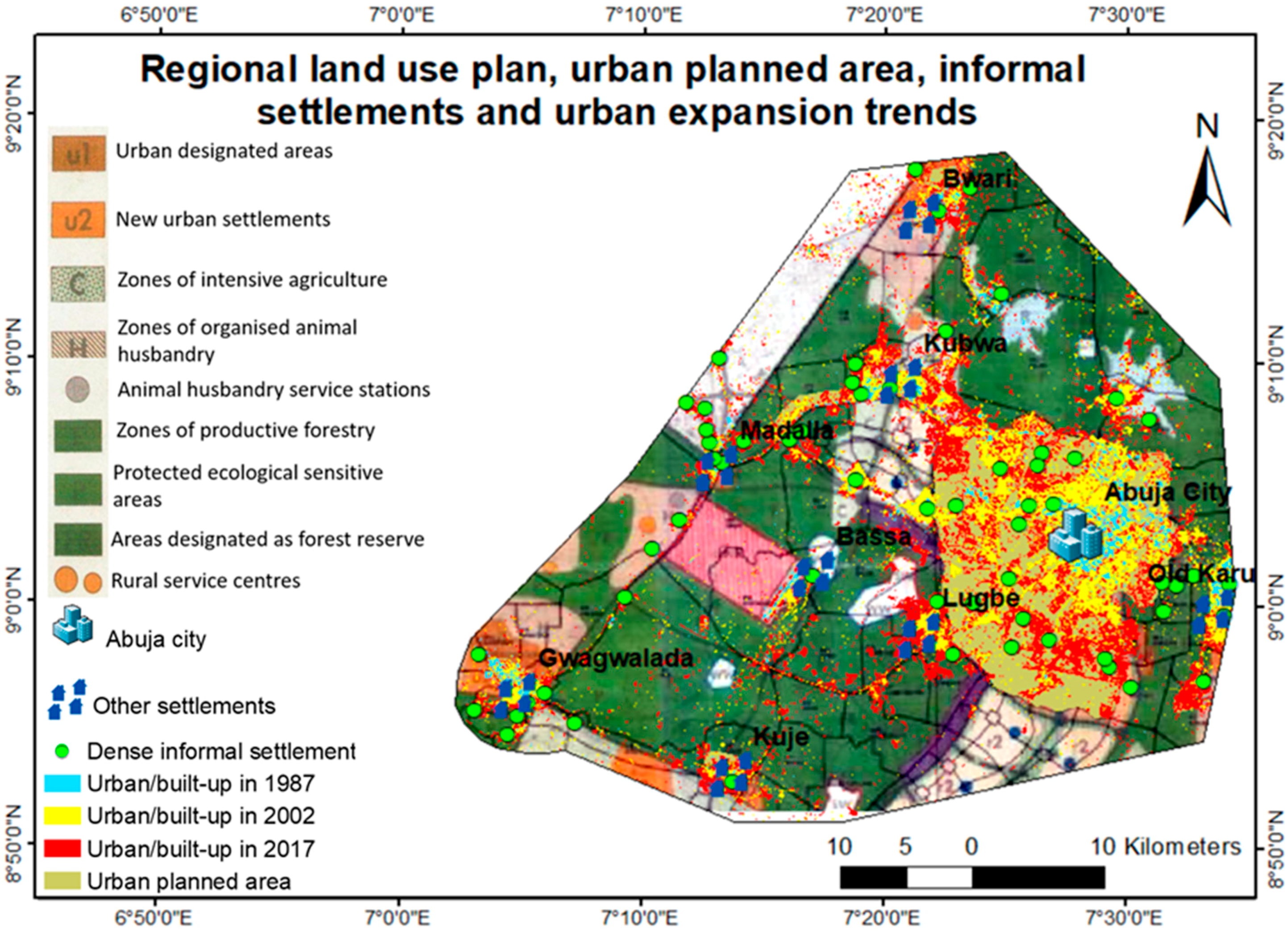
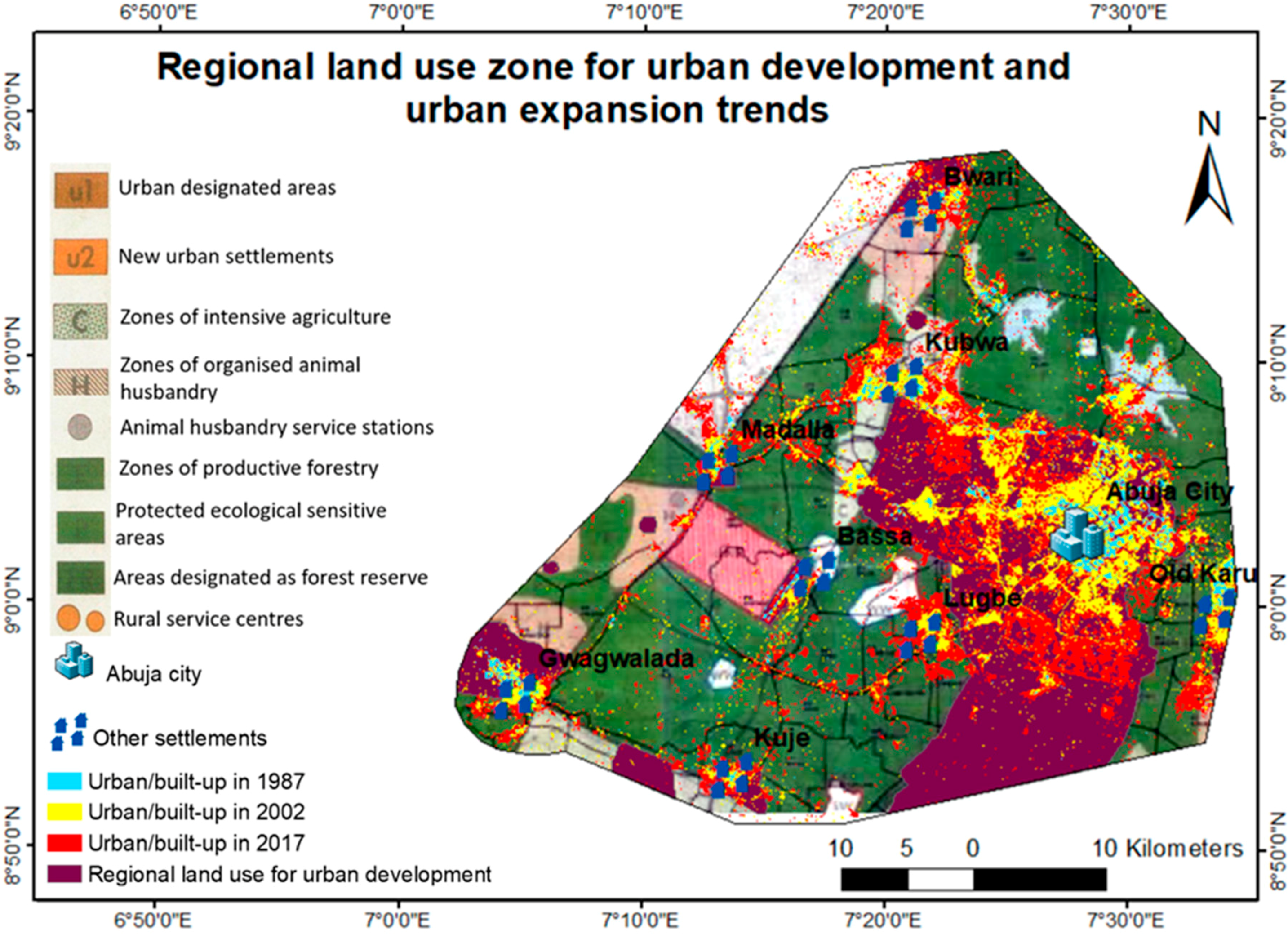


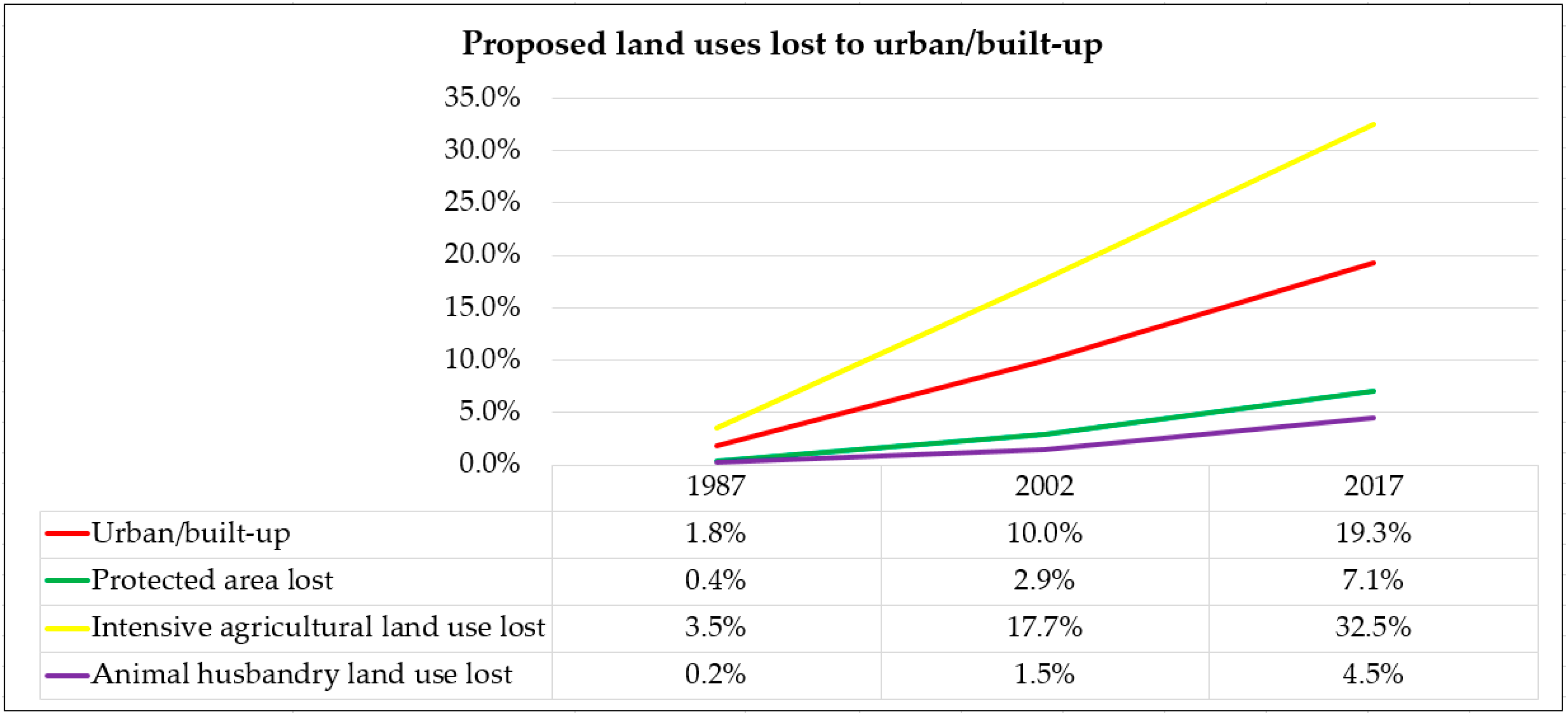
| Landsat Series | Sensor | Spatial Resolution | No: of Bands | Date of Acquisition | Sources |
|---|---|---|---|---|---|
| Landsat 4 | TM | 30 m | 7 | 21/12/1987 | USGS |
| Landsat 7 | ETM+ | 30 m | 9 | 30/12/2002 | USGS |
| Landsat 8 | OLI | 30 m | 11 | 14/02/2017 | USGS |
| Land Cover Classes | Description of Land Cover |
|---|---|
| Urban/built-up | Elements of urban/rural settlements such as buildings, roads, etc. |
| Vegetation | Forest vegetation: Tall trees that form canopy as healthy vegetation. Savannah vegetation: Isolated short trees mixed with grasses. |
| Bare land | All other surfaces such as open space with bare soil, rocks. |
| Water | Lakes and other water bodies. |
| Land Cover Classes | 1987 | 2002 | 2017 |
|---|---|---|---|
| Area km2 (% of Study Area) | Area km2 (% of Study Area) | Area km2 (% of Study Area) | |
| Urban/built-up | 36.8 (1.8%) | 198.8 (10.0%) | 385.4 (19.3%) |
| Vegetation | 1455.6 (73.0%) | 1262.5 (63.3%) | 1011.9 (50.8%) |
| Bare land | 491.9 (24.7%) | 522.1 (26.2%) | 588.6 (29.5%) |
| Water | 9.3 (0.5%) | 9.6 (0.5%) | 7.7 (0.4%) |
| Total | 1993.6 (100.0%) | 1993.0 (100.0%) | 1993.6 (100.0%) |
| Land Cover Classes | 1987 | 2002 | 2017 | |||||||||
|---|---|---|---|---|---|---|---|---|---|---|---|---|
| UA | PA | OA | KC | UA | PA | OA | KC | UA | PA | OA | KC | |
| Urban/built-up | 91% | 94.8% | 94% | 0.91 | 88% | 87.8% | 92.6% | 0.89 | 96% | 85.3% | 94% | 0.91 |
| Vegetation | 97.5% | 97.5% | 94.5% | 95.9% | 95% | 98.4% | ||||||
| Bare land | 93.3% | 88.6% | 94.7% | 89.3% | 94.7% | 94% | ||||||
| Water | 88% | 95.6% | 88% | 95.7% | 84% | 97.7% | ||||||
| Years | Regional Planned Area for Urban Development in km2 | Urban/Built-up Area in km2 | Urban/Built-up in Non-urban Development Area in km2 |
|---|---|---|---|
| 1987 | 555.25 | 36.8 | 11.65 |
| 2002 | 555.25 | 198.8 | 73.58 |
| 2017 | 555.25 | 385.4 | 179.57 |
© 2019 by the authors. Licensee MDPI, Basel, Switzerland. This article is an open access article distributed under the terms and conditions of the Creative Commons Attribution (CC BY) license (http://creativecommons.org/licenses/by/4.0/).
Share and Cite
Enoguanbhor, E.C.; Gollnow, F.; Nielsen, J.O.; Lakes, T.; Walker, B.B. Land Cover Change in the Abuja City-Region, Nigeria: Integrating GIS and Remotely Sensed Data to Support Land Use Planning. Sustainability 2019, 11, 1313. https://doi.org/10.3390/su11051313
Enoguanbhor EC, Gollnow F, Nielsen JO, Lakes T, Walker BB. Land Cover Change in the Abuja City-Region, Nigeria: Integrating GIS and Remotely Sensed Data to Support Land Use Planning. Sustainability. 2019; 11(5):1313. https://doi.org/10.3390/su11051313
Chicago/Turabian StyleEnoguanbhor, Evidence Chinedu, Florian Gollnow, Jonas Ostergaard Nielsen, Tobia Lakes, and Blake Byron Walker. 2019. "Land Cover Change in the Abuja City-Region, Nigeria: Integrating GIS and Remotely Sensed Data to Support Land Use Planning" Sustainability 11, no. 5: 1313. https://doi.org/10.3390/su11051313
APA StyleEnoguanbhor, E. C., Gollnow, F., Nielsen, J. O., Lakes, T., & Walker, B. B. (2019). Land Cover Change in the Abuja City-Region, Nigeria: Integrating GIS and Remotely Sensed Data to Support Land Use Planning. Sustainability, 11(5), 1313. https://doi.org/10.3390/su11051313







